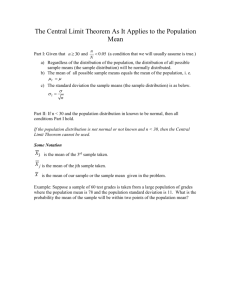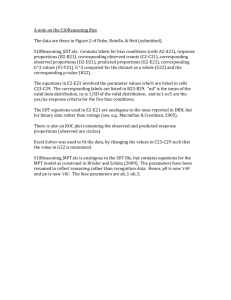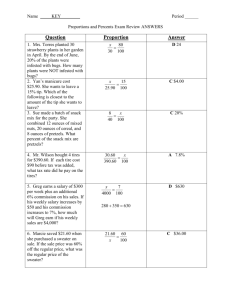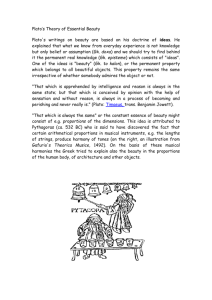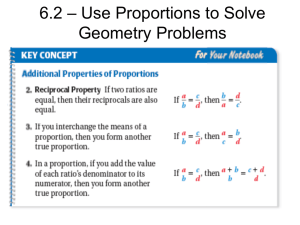the measure of a person: formulating human proportions
advertisement
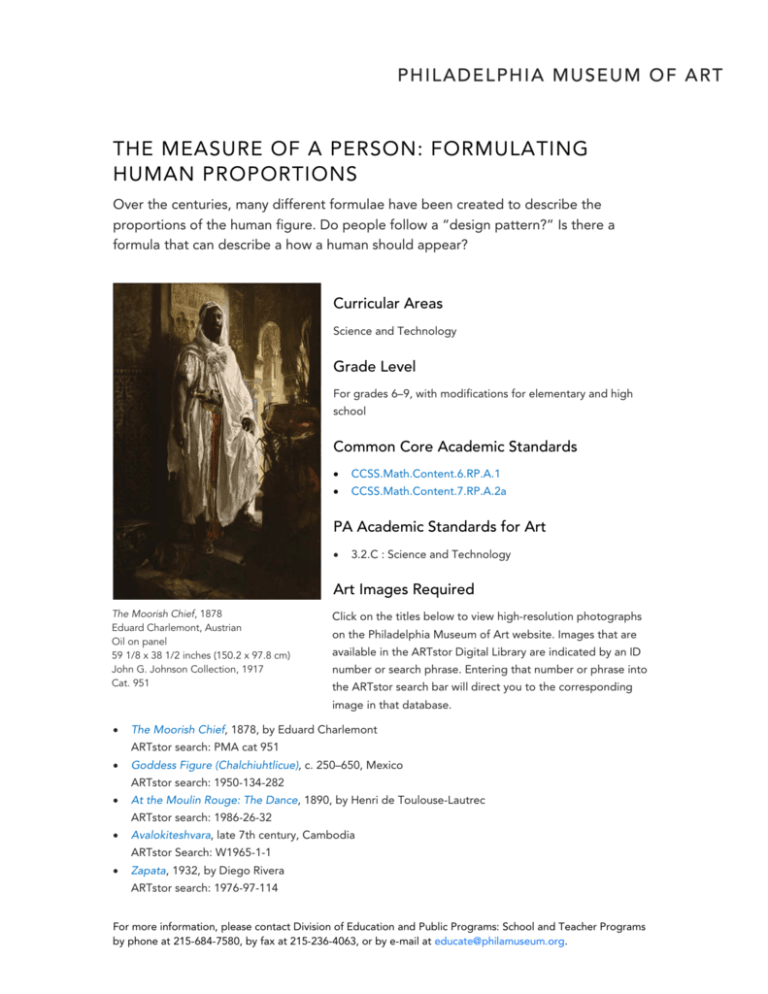
THE MEASURE OF A PERSON: FORMULATING HUMAN PROPORTIONS Over the centuries, many different formulae have been created to describe the proportions of the human figure. Do people follow a “design pattern?” Is there a formula that can describe a how a human should appear? Curricular Areas Science and Technology Grade Level For grades 6–9, with modifications for elementary and high school Common Core Academic Standards • CCSS.Math.Content.6.RP.A.1 • CCSS.Math.Content.7.RP.A.2a PA Academic Standards for Art • 3.2.C : Science and Technology Art Images Required The Moorish Chief, 1878 Eduard Charlemont, Austrian Oil on panel 59 1/8 x 38 1/2 inches (150.2 x 97.8 cm) John G. Johnson Collection, 1917 Cat. 951 Click on the titles below to view high-resolution photographs on the Philadelphia Museum of Art website. Images that are available in the ARTstor Digital Library are indicated by an ID number or search phrase. Entering that number or phrase into the ARTstor search bar will direct you to the corresponding image in that database. • The Moorish Chief, 1878, by Eduard Charlemont ARTstor search: PMA cat 951 • Goddess Figure (Chalchiuhtlicue), c. 250–650, Mexico ARTstor search: 1950-134-282 • At the Moulin Rouge: The Dance, 1890, by Henri de Toulouse-Lautrec ARTstor search: 1986-26-32 • Avalokiteshvara, late 7th century, Cambodia ARTstor Search: W1965-1-1 • Zapata, 1932, by Diego Rivera ARTstor search: 1976-97-114 For more information, please contact Division of Education and Public Programs: School and Teacher Programs by phone at 215-684-7580, by fax at 215-236-4063, or by e-mail at educate@philamuseum.org. Lesson Process 1. To prepare for this lesson, ask students to bring in full-length magazine photos of people. 2. Distribute as a hand-out (or list on the board) the following classic proportions: according to the early Roman architect Vitruvius, there are certain proportions that are typical of the human body. These include the following: o A palm is the width of four fingers o A foot is the width of four palms o A man’s height is 24 palms o The length of a man’s outspread arms is equal to his height o The distance from the hairline to the bottom of the chin is 1/10 of a man’s height o The distance from the top of the head to the bottom of the chin is 1/8 of a man’s height o The distance from the elbow to the tip of the hand is 1/5 of a man’s height o The distance from the elbow to the armpit is 1/8 of a man’s height o The length of the hand is 1/10 of a man’s height o The distance from the bottom of the chin to the nose is 1/3 of the length of the head o The distance from the hairline to the eyebrows is 1/3 of the length of the face o The length of the ear is 1/3 of the length of the face 3. Add that Leonardo da Vinci revised and added to Vitruvius’s proportions. He noted that the length of the human face (from chin to top of the head) is 1/7 of the length of the human body. MODIFICATION, HIGH SCHOOL: Students may research these proportions from websites about Vitruvius and da Vinci. The details from da Vinci’s writings can be found in translations from his Notebook VII, which can be found here: http://www.fromoldbooks.org/Richter-NotebooksOfLeonardo/section-7/. 4. Select a classroom partner. Using measuring instruments, check the accuracy of these proportions. If any individual proportions vary from the classic descriptions, compute classroom averages to see if the variant results are outside the norm. 5. Use measuring instruments to check whichever proportions can be measured on the pictures students brought from magazines, etc. 6. Following a similar methodology, check human proportions found in the list of works mentioned above (Art Images Required). 7. Discuss the observations of the class as they examine these examples. Draw conclusions regarding the accuracy of these proportions. Where proportions differ, discuss why the artist may have used them anyway. What effects do these disproportionalities have on the way the viewer perceives the artworks? 8. Apply what you have learned by attempting to draw a human face using Vitruvius’s proportions. Draw your face on graph paper so that proportions can be accurately measured. MODIFICATION, ELEMENTARY: students should select a partner and, using brown craft paper, trace their partner’s body. Have students measure their palms to see how many palms-long their bodies are. Experiment with other measurements, as well. For more information, please contact Division of Education and Public Programs: School and Teacher Programs by phone at 215-684-7580, by fax at 215-236-4063, or by e-mail at educate@philamuseum.org. Assessment ELEMENTARY 1. Allow students to provide their palm measurements (from modification above) into a chart. Then, using brown paper as above, trace an adult figure. Are the proportions the same? How do they differ? Compare the adult and the student drawings. Which are closer to Vitruvius’s proportions? GRADES 7–12 1. If these proportions can duplicate an average or typical human form, are there outliers? What about professional basketball players or supermodels? Is there a different set of proportions that describe these groups? Explore this topic and write your results as an expository or informational essay. Enrichment ELEMENTARY 1. Bundle the list of proportions into two groups: those involving the face and those involving use of the hand. Concentrate on only one bundle of proportions. Review the use and meaning of fractions in this context, perhaps with self-generated proportions such as “How many fingers wide is your face?” GRADES 7–12 1. Research other proportions or formulae used by artists to depict the human form. Compare these other attempts with that of Vitruvius. Why do you think these other formulae were used? What effect do they have on the overall experience of the figure? 2. Can proportions also be used to describe other living things? Research standard measurements and discover proportions for another species of plant or animal (dogs, cats, oak trees, daisies, etc.). Make note of how many examples you measured before you came to your conclusions. 3. What happens when you exaggerate proportions? Choose a part of the body and make it smaller or larger than the formulae above would indicate. What is the effect of this change? Can you think of any artists who have used this exaggeration as a technique? For more information, please contact Division of Education and Public Programs: School and Teacher Programs by phone at 215-684-7580, by fax at 215-236-4063, or by e-mail at educate@philamuseum.org.

